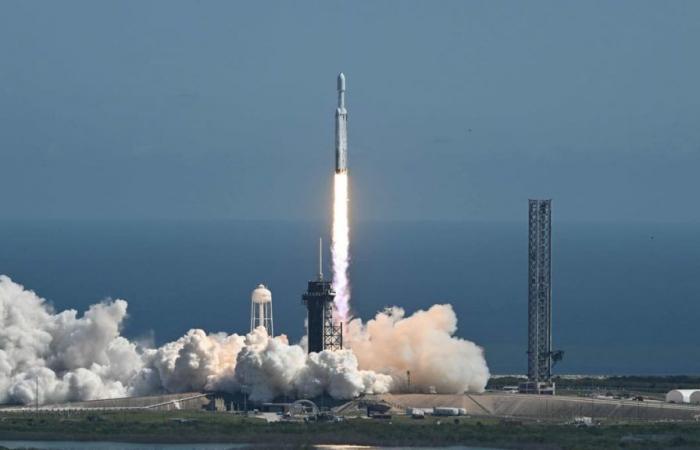A NASA probe named Europa Clipper took off from the United States on Monday towards a moon of Jupiter, to discover if it has the ingredients that would allow it to harbor life in an ocean of liquid water.
• Also read: Possible life on a moon of Jupiter? NASA goes to investigate
Liftoff took place aboard SpaceX’s powerful Falcon Heavy rocket from the Kennedy Space Center in Florida. The probe will reach Europa, one of Jupiter’s many moons, in April 2030.
Here are the images of the takeoff
AFP
AFP
AFP
AFP
AFP
Possible life beyond Earth?
This is a world that the American space agency has never before observed in such detail: beneath its icy surface lies an ocean of liquid water, scientists believe.
“Europe is one of the most promising places to look for life beyond Earth,” Gina DiBraccio, head of NASA, said at a press conference.
The mission will not directly look for signs of life, but will answer the question of habitability: does Europe contain the ingredients that would allow life to be present there?
If this is the case, then another mission will have to go there to try to detect it.
“This is an opportunity for us to explore not a world that may have been habitable billions of years ago,” like Mars, “but a world that could be habitable today, right now », enthused Curt Niebur, scientific manager for the mission.
The largest probe ever designed
The probe is the largest ever designed by NASA for interplanetary exploration: 30 meters wide once its immense solar panels are extended. These were designed to capture the faint light reaching Jupiter.
The first close-up images of Europa, known to exist since 1610, were taken by the legendary Voyager probes in 1979, which revealed the mysterious reddish lines streaking its surface.
It was then flown by the Galileo probe in the 1990s, which confirmed the very probable presence of an ocean.
This time, Europa Clipper carries numerous ultra-sophisticated instruments — cameras, spectrograph, radar, magnetometer…
The objective of the mission?
The mission is expected to determine the structure and composition of its icy surface, the depth and even salinity of its ocean, and how the two interact – for example, whether water rises to the surface in places.
All in order to understand if the three ingredients necessary for life are indeed present: water, energy and certain chemical compounds.
A priori, if it exists, life would be found in the ocean in the form of primitive bacteria, explained Bonnie Buratti, deputy scientific manager of the mission. But too deep for Europa Clipper to see.
What if Europe was ultimately not habitable? “It would also open up a whole series of questions: why did we think that and why isn’t it there?” said Nikki Fox, associate administrator at NASA.
In five and a half years of travel to reach Jupiter, the probe will travel 2.9 billion kilometers. From its arrival, the main mission will last four years.
The probe will make 49 close flybys over Europa, up to 25 kilometers from the surface.
She will then be subjected to intense radiation – the equivalent of several million chest x-rays each time.
Some 4,000 people have worked for about a decade on the mission, which cost $5.2 billion.
An investment justified by the importance of the data to be collected, according to NASA.
If our solar system turns out to be home to two habitable worlds (Europa and Earth), “think about what that means when you extend that to the billions of other solar systems in this galaxy,” said Curt Niebur.
“Even putting aside the question of whether there is life on Europa, the question of habitability alone opens a new paradigm for the search for life in the galaxy,” he added.
Europa Clipper will operate at the same time as the Juice probe of the European Space Agency (ESA), which must study two other moons of Jupiter, Ganymede and Callisto, in addition to Europa.





